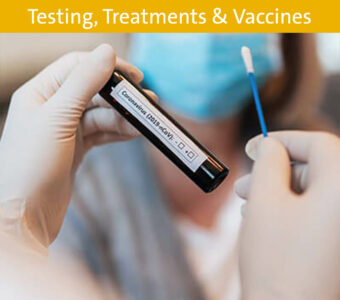Around the world, top researchers and scientists are working diligently to produce a SARS-CoV-2, or COVID-19, vaccination. For months now, the general public has been concerned about the vaccine trials and rush to get a product released.
While researchers are conscious of the demand for a COVID-19 vaccine, they are following the formal vaccination process in order to produce an effective and safe vaccine. The only difference between the process for past vaccines and what’s being done now to develop a COVID-19 vaccine, is the accelerated timeline.
So, what exactly does this process entail, and what is its timeline? Let’s break down the vaccine development process, step by step.
The following information is available through the Centers for Disease Control and Prevention (CDC), the United States Food and Drug Administration (FDA) and the History of Vaccines websites. For more information, please visit these sites.
Vaccine approval process
The FDA’s Center for Biologics Evaluation and Research is responsible for regulating vaccines in the United States. The sponsor of a new vaccine, usually a private company, will follow this multistep approval process, starting with the submission of an Investigational New Drug Application.
Clinical development
Phase I
Phase I is the first clinical trial with human subjects. The trial vaccine will be administered to small groups of adults, typically between 20–80 people. Researchers will then observe the results of each person who was given the trial vaccine.
Two testing methods may be used during this step:
- Open-label: Both the researchers and subjects may be aware of whether the subjects were given the trial vaccine or a placebo.
- Challenge model: Subjects may be exposed to the infection after being given the trial vaccine, to ensure it has the intended effect.
No matter which testing method is used in this stage, once a promising trial is identified, researchers can move on to phase II.
Phase II
After the success of phase I, the clinical study is expanded during phase II. The trial vaccine will now be given to several hundred participants, some who may have similar at-risk characteristics (such as age or physical health) to those who will need the new vaccine once it’s available. Participant groups included in this phase are randomized and thoroughly observed. A placebo group is also included.
The goal of phase II is to not only study the vaccine’s safety and its ability to produce an immune response, but also to start understanding possible doses, a vaccination schedule and method of delivery. Successful completion of phase II allows researchers to move on to the final stage of clinical development.
Phase III
Participant groups grow from hundreds to thousands of people in phase III. These tests, like the tests completed in phases I and II, are used to study safety and efficacy, and are randomized as well. Researchers in phase III are also searching for potential, rare side effects that may not have surfaced in previous small-group tests.
Toward the end of phase III, researchers are asking these three questions:
- Does the candidate vaccine prevent disease?
- Does the candidate vaccine prevent infection with the pathogen?
- Does the candidate vaccine produce antibodies or other types of immune responses related to the pathogen?
If these questions are answered yes, the vaccine developer will move on to submitting a Biologics License Application to the FDA.
Biologics License Application
For the Biologics License Application to be considered, it must provide efficacy and safety information so the multidisciplinary FDA review team can make a risk and benefit assessment of the candidate vaccine. The proposed manufacturing facility is also inspected and approved. If everything checks out, the license will be approved.
Findings presentation
After the approval of the Biologics License Application, both the vaccine sponsor and the FDA may present their findings to the FDA’s Vaccines and Related Biological Products Advisory Committee. This is a committee of scientists, physicians, biostatisticians and a consumer representative. It is the duty of this committee to offer safety and efficacy advice.
Manufacturing
If approved, major drug manufacturers begin to provide the infrastructure, personnel and equipment necessary to produce the vaccine. The FDA will continue to oversee production during this stage to ensure safety. This monitoring must continue as long as a manufacturer holds a license for the vaccine.
Quality control
The Vaccine Adverse Event Reporting System tracks side effects of a vaccine once administered. They are a safety surveillance program co-sponsored by the FDA and the CDC. Any concerned individual, including patients, parents, healthcare providers, pharmacists and vaccine manufacturers, can submit a report to the system. All reports will be investigated by the CDC to figure out if the event was caused by the vaccination.
If you think you may have come into contact with someone who has COVID-19, call your primary care doctor or the Ohio Department of Health call center. The call center is now open seven days a week from 9 a.m. to 8 p.m. to answer your COVID-19 questions, and can be reached at 1 (833) 4-ASK-ODH (1 (833) 427-5634).
The information in this article was updated on November 5, 2020. For the latest information concerning COVID-19, visit the CDC’s website.






